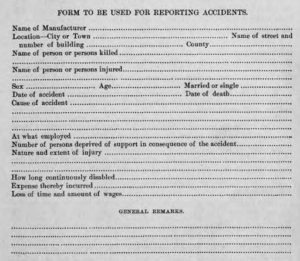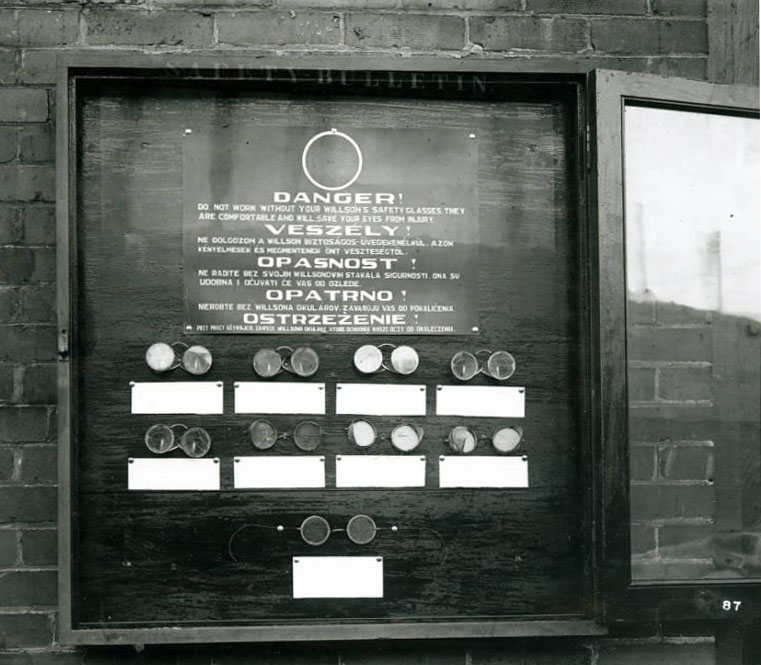Shades of Green: Reports of the Department of the Inspection of Workshops and Factories

In May 2013 we introduced you to an Ohio Memory collection that is of interest to genealogists but may have been overlooked as a source of genealogical information. We called our blog post “Shades of Green,” saying that, while vital records give us a good, solid outline on our family tree, there are other materials that color the leaves of our tree in shades of green. We would like to introduce you to another of these items: the Annual Report of the Inspection of Workshops and Factories.

The Inspector of Workshops and Factories was governor-appointed, according to the Revised Statutes of Ohio. His role was to “… [inspect] the sanitary condition, comfort and safety of shops and factories….” As such, he visited facilities employing at least ten people; inspected plumbing, heating, ventilation, and lighting conditions; ensured that adequate exits were available; inspected machinery to ascertain safety; and determined whether proper safety precautions were taken when factories dealt with hazardous materials, such as molten metals. The inspector was to give shop proprietors 30 days to become compliant, after which any proprietor not in compliance would be charged with a misdemeanor. The reports contain information from these inspections, including names of proprietors and locations for their businesses, as well as other data of interest.
As part of each annual report, the inspector provided accounts on accidents in the facilities he visited. Often, these accounts involved more than just a description of the accident; when available, names and addresses of accident victims, their condition as a result of the accident, names of survivors (when the victim died as a result of the event), and other information was included in the report. These reports were frequently gruesome, particularly when the victim died from his injuries. Genealogists, however, often appreciate discovering details such as these; again, a death date is part of the outline of a person’s life, but descriptions and stories add color and vibrancy, making the individual more real. If the individual did not die, accident reports may explain a sudden loss of social status, which can be reflected in census records but may be difficult to understand otherwise. Again, this breathes life into our long-dead ancestors’ stories, coloring our family tree.

Take, for example, the May 31, 1888, incident in which 30-year-old Thomas Foulkes sustained an injury to his hand while working as an engineer for the Cleveland Rolling Mill. Foulkes was hurt when his hand was caught in a belt connected with a stem pump. The report indicates that his wife and three children were deprived of support as a result of the injury and that, at the time of the report on June 14, he was still unable to work and was losing $2.90 per day, a significant sum in 1888. If the 1880 census showed Foulkes as an engineer, but a subsequent census showed him as a laborer and living under decreased circumstances, the incident report could explain the change. The report is also valuable as a resource due to the fact that the 1890 U.S. federal census was destroyed by a fire and researchers have had to turn to other sources of information to fill holes left by the loss. The report on Mr. Foulkes places him in Cleveland, and lists a wife and three children, which is useful data for genealogical researchers who are facing this very significant gap in source material.
If you are not a genealogist, the report is still of value as a historical document. The U.S Department of Labor indicates that, for the most part, businesses responded favorably to the advent of the inspector’s work; readers can learn about which situations merited warnings for change, and can see response rates. As part of the broader picture, the reports can be placed in the period that led up to the Progressive Era, which began in 1890 and focused on providing access to education, a safe environment, and a healthy workplace as a means to social justice.
We hope that, regardless of your research goals, you will take time to view these documents. Yes, they provide shades of green for genealogists, but we believe that they will add color to other types of research, as well.
Thank you to Shannon Kupfer, Digital Initiatives Librarian at theState Library of Ohio, for this week’s post!



Leave a Reply
You must be logged in to post a comment.